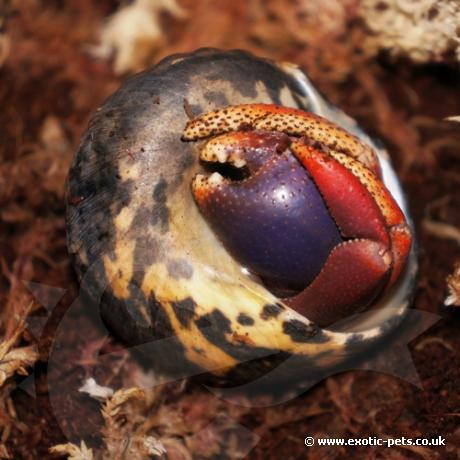

Purple Clawed Hermit Crabs are one of the best beginner species to keep and maintain. They are very sociable and do best kept in large groups, this also makes them more active and fun to watch.
The Purple Clawed Hermit Crab has been given this name due to its large purple claw. They use this not only to break off food while feeding, it also blocks the entrance of their shell from predators. Their legs tend to be a yellow/orange while young, as they mature the legs darken and become a red/brown colour. When they are due to moult their skink, the purple claw becomes very dark and dull looking.
As with all Hermit Crabs they carry a shell on their back to protect their fragile bodies. Before selecting a new shell, they inspect the amount of space inside and the weight. If they feel comfortable with it, they will simply slip out of the old shell into the new one.
Keep all Purple Clawed Hermit Crabs in groups, never on their own as they are very sociable. In the wild they can be found in large groups from small babies to large fully grown adults. They will communicate with each other by making ticking a squeaky sounds and seem to swap shells on a regular basis.
Purple Clawed Hermit Crabs are found in the tropics such as the Caribbean like Barbados, however they do not like direct sunlight or high temperatures. They prefer to hide during the peak of day and venture out for food in cooler afternoons or after heavy rains.
During the day, they hide in shallow burrows, under fallen branches, leaves and rocks. They are most active during the night when the temperature is lower, searching for foods. If it is a very humid day or has rained, hermit crabs have been found wondering around the forest floor.
Purple Clawed Hermit Crabs are one of the most popular species of Hermit Crabs to keep due to their easy of care and requirements. These are one of the best species to start with and are ideal for beginners.
There are two main types of set-ups that your hermit crabs will love. The first is a seashore set-up, providing them with a sand substrate, logs and rocks to hide under. The second is a forest set-up, providing a soil and bark chip substrate, logs, and rocks and even live plants. The live plants may be ripped and parts eaten, but if you are looking for a display tank.
Provide a temperature of 23 - 28C, a heat mat may be placed on one side of the tank however, we would recommend a small basking light connected to a thermostat. The humidity within the enclosure should be towards 70% however, 55-60% will be OK. When the humidity is increased by regular misting of water, they become active and will search for food during the day.
The enclosure must have a shallow water dish of treated water (see below), so they may drink and clean out their shell, we also recommend a salt water as well. Place food in a shallow feed dish, this will help when changing the food every few days. Feeding isn't a problem for hermit crabs, in the wild they are scavengers and will eat pretty much anything that is edible. They will eat the following; fruit, vegetables, meat, dog and cat biscuits, seeds, cereal, dead insects, flowers and plants (none poisonous plants) and you can buy commercial hermit crab food.
You must also place a number of spare shells within the enclosure. Hermit crabs will swap and change shells quite often, although they may stay in the same shell after moulting. You can sometimes tell if your hermit crab is due for a moult, they become less active, do not eat much and burrow down into the substrate. Never disturb them, as this is a fragile time for your exotic pet. There skin becomes soft and they can easily be injured and dry out. The moult can last up to a month before they surface and start to feed and drink.
Have a look at our Hermit Crab Accessories.
Caution: When providing water for your hermit crabs, this MUST be treated with an Aquarium de-chlorinated solution. The Chlorine will harm and possible kill your hermit crabs after a period of time. Alternatively, you can use fresh, clean rainwater!